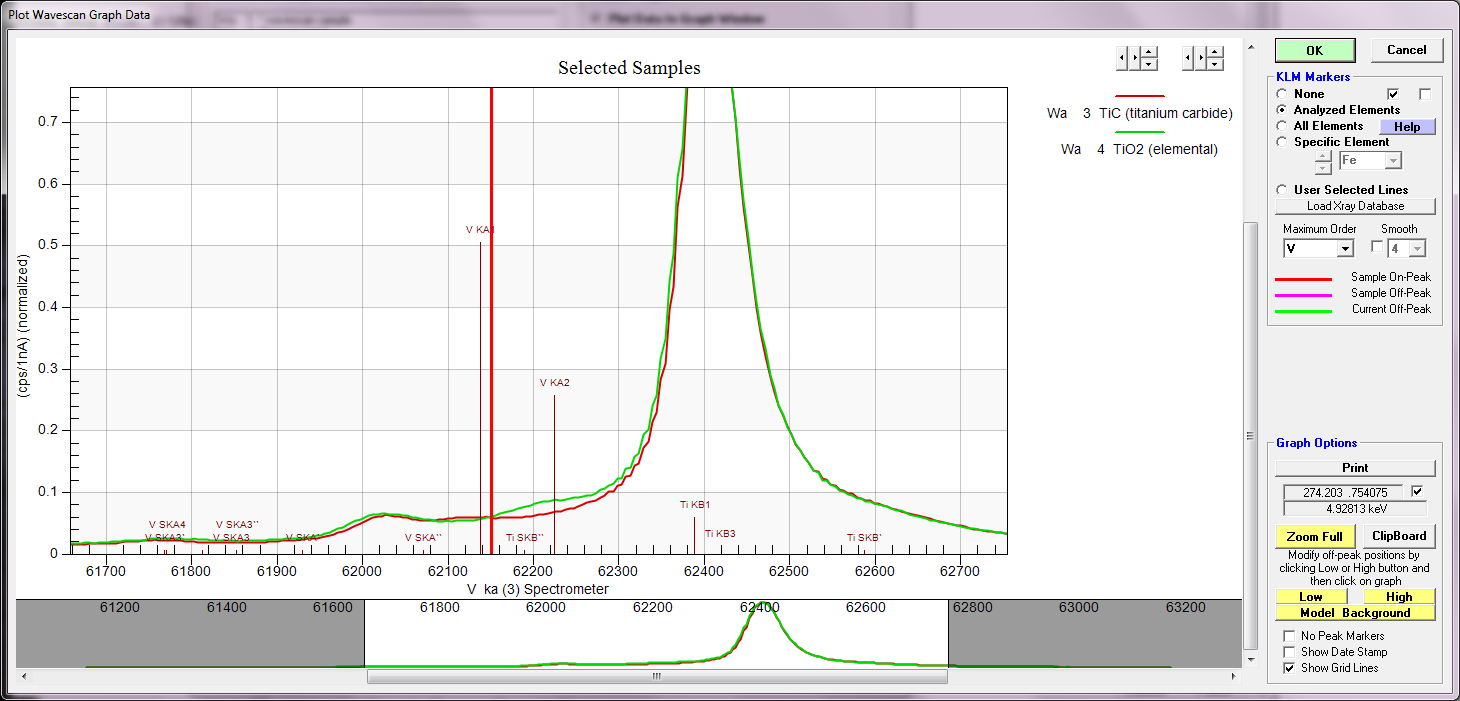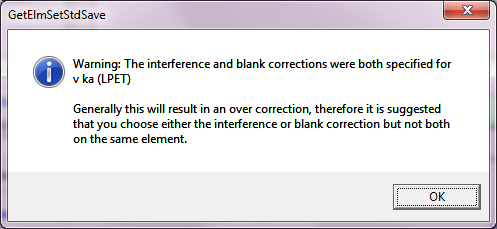I ran some additional high precision (15 keV, 50 nA, 10 um, 100 seconds per point, 400 points) scans on both LLIF and LPET crystals. Here are the LLIF scans for Va Ka on both TiO2 and TiC normalized to the Ti Kb:

and here for LPET:

So I don't understand completely what is going on but here's a few observations regrading these interferences/blank corrections when analyzing TiC using TiO2 for both the primary standard and for the interference standard for the quantitative interference correction... it's amazing it works as well as it does!

First here we have no interference or blank corrections using only LIF crystals on TiC:
ELEM: Ti Ti-D V V-D Sr Fe Cr Mn C SUM
XRAY: (ka) (ka) (ka) (ka) () () () () ()
162 78.759 --- .725 --- .000 .000 .000 .000 20.000 99.484
163 78.540 --- .720 --- .000 .000 .000 .000 20.000 99.260
164 78.196 --- .723 --- .000 .000 .000 .000 20.000 98.919
165 78.437 --- .737 --- .000 .000 .000 .000 20.000 99.174
166 78.628 --- .720 --- .000 .000 .000 .000 20.000 99.348
167 78.765 --- .701 --- .000 .000 .000 .000 20.000 99.466
AVER: 78.554 --- .721 --- .000 .000 .000 .000 20.000 99.275
SDEV: .216 --- .012 --- .000 .000 .000 .000 .000 .211
SERR: .088 --- .005 --- .000 .000 .000 .000 .000
%RSD: .28 --- 1.63 --- .00 .00 .00 .00 .00
STDS: 922 --- 923 --- --- --- --- --- ---
If we turn on the interference correction using TiO2 as our interference standard only we get this:
ELEM: Ti Ti V V Sr Fe Cr Mn C
TYPE: ANAL ANAL ANAL ANAL SPEC SPEC SPEC SPEC SPEC
BGDS: LIN EXP LIN EXP
TIME: 60.00 --- 60.00 --- --- --- --- --- ---
BEAM: 30.03 --- 30.03 --- --- --- --- --- ---
ELEM: Ti Ti-D V V-D Sr Fe Cr Mn C SUM
XRAY: (ka) (ka) (ka) (ka) () () () () ()
162 78.797 --- .008 --- .000 .000 .000 .000 20.000 98.805
163 78.577 --- .005 --- .000 .000 .000 .000 20.000 98.583
164 78.233 --- .011 --- .000 .000 .000 .000 20.000 98.245
165 78.474 --- .024 --- .000 .000 .000 .000 20.000 98.498
166 78.665 --- .004 --- .000 .000 .000 .000 20.000 98.670
167 78.803 --- -.016 --- .000 .000 .000 .000 20.000 98.787
AVER: 78.592 --- .006 --- .000 .000 .000 .000 20.000 98.598
SDEV: .216 --- .013 --- .000 .000 .000 .000 .000 .209
SERR: .088 --- .005 --- .000 .000 .000 .000 .000
%RSD: .28 --- 211.68 --- .00 .00 .00 .00 .00
STDS: 922 --- 923 --- --- --- --- --- ---
The vanadium is within a standard deviation. One could also simply apply the TiC standard (acquired as an unknown) as a blank without an interference correction as seen here:
ELEM: Ti Ti-D V V-D Sr Fe Cr Mn C SUM
XRAY: (ka) (ka) (ka) (ka) () () () () ()
174 78.239 --- .012 --- .000 .000 .000 .000 20.000 98.252
175 78.794 --- .003 --- .000 .000 .000 .000 20.000 98.796
176 78.508 --- .017 --- .000 .000 .000 .000 20.000 98.525
177 78.669 --- .013 --- .000 .000 .000 .000 20.000 98.682
178 78.899 --- -.005 --- .000 .000 .000 .000 20.000 98.895
AVER: 78.622 --- .008 --- .000 .000 .000 .000 20.000 98.630
SDEV: .259 --- .009 --- .000 .000 .000 .000 .000 .252
SERR: .116 --- .004 --- .000 .000 .000 .000 .000
%RSD: .33 --- 109.73 --- .00 .00 .00 .00 .00
PUBL: 80.000 n.a. n.a. n.a. n.a. n.a. n.a. n.a. 20.000 100.000
%VAR: -1.72 --- --- --- --- --- --- --- .00
DIFF: -1.378 --- --- --- --- --- --- --- .000
STDS: 922 --- 923 --- --- --- --- --- ---
Also within a standard deviation. In this case either the interference correction or the blank correction appear to work equally well.
Now let's do a "failure mode" analysis on PET crystals! Again, not recommended, but an interesting failure mode test. Here is the TiC without an interference correction or a blank correction:
ELEM: Ti-D Ti V-D V Sr Fe Cr Mn C SUM
XRAY: (ka) (ka) (ka) (ka) () () () () ()
162 --- 80.029 --- 3.952 .000 .000 .000 .000 20.000 103.980
163 --- 80.008 --- 3.968 .000 .000 .000 .000 20.000 103.977
164 --- 79.856 --- 3.965 .000 .000 .000 .000 20.000 103.821
165 --- 79.888 --- 3.966 .000 .000 .000 .000 20.000 103.854
166 --- 79.687 --- 3.947 .000 .000 .000 .000 20.000 103.634
167 --- 79.986 --- 4.003 .000 .000 .000 .000 20.000 103.989
AVER: --- 79.909 --- 3.967 .000 .000 .000 .000 20.000 103.876
SDEV: --- .129 --- .020 .000 .000 .000 .000 .000 .139
SERR: --- .053 --- .008 .000 .000 .000 .000 .000
%RSD: --- .16 --- .50 .00 .00 .00 .00 .00
STDS: --- 922 --- 923 --- --- --- --- ---
That's a big interference! Now let's turn on the interference correction using TiO2 as the interference standard:
ELEM: Ti-D Ti V-D V Sr Fe Cr Mn C SUM
XRAY: (ka) (ka) (ka) (ka) () () () () ()
162 --- 80.229 --- -.030 .000 .000 .000 .000 20.000 100.199
163 --- 80.209 --- -.014 .000 .000 .000 .000 20.000 100.195
164 --- 80.056 --- -.012 .000 .000 .000 .000 20.000 100.044
165 --- 80.088 --- -.014 .000 .000 .000 .000 20.000 100.075
166 --- 79.887 --- -.025 .000 .000 .000 .000 20.000 99.862
167 --- 80.187 --- .014 .000 .000 .000 .000 20.000 100.202
AVER: --- 80.110 --- -.014 .000 .000 .000 .000 20.000 100.096
SDEV: --- .129 --- .015 .000 .000 .000 .000 .000 .134
SERR: --- .053 --- .006 .000 .000 .000 .000 .000
%RSD: --- .16 --- -114.32 .00 .00 .00 .00 .00
STDS: --- 922 --- 923 --- --- --- --- ---
A bit of an over correction, but still within a standard deviation! Now just the blank correction using TiC as the blank:
ELEM: Ti-D Ti V-D V Sr Fe Cr Mn C SUM
XRAY: (ka) (ka) (ka) (ka) () () () () ()
174 --- 80.149 --- .041 .000 .000 .000 .000 20.000 100.191
175 --- 79.987 --- .036 .000 .000 .000 .000 20.000 100.023
176 --- 80.062 --- .026 .000 .000 .000 .000 20.000 100.088
177 --- 80.420 --- .040 .000 .000 .000 .000 20.000 100.461
178 --- 80.240 --- .047 .000 .000 .000 .000 20.000 100.287
AVER: --- 80.172 --- .038 .000 .000 .000 .000 20.000 100.210
SDEV: --- .168 --- .008 .000 .000 .000 .000 .000 .172
SERR: --- .075 --- .003 .000 .000 .000 .000 .000
%RSD: --- .21 --- 20.47 .00 .00 .00 .00 .00
PUBL: n.a. 80.000 n.a. n.a. n.a. n.a. n.a. n.a. 20.000 100.000
%VAR: --- .21 --- --- --- --- --- --- .00
DIFF: --- .172 --- --- --- --- --- --- .000
STDS: --- 922 --- 923 --- --- --- --- ---
Not as good as the interference correction. Let's try turning both on! First the software warns us with this message:

and here are the results with both corrections turned on:
ELEM: Ti-D Ti V-D V Sr Fe Cr Mn C SUM
XRAY: (ka) (ka) (ka) (ka) () () () () ()
174 --- 80.169 --- -.341 .000 .000 .000 .000 20.000 99.829
175 --- 80.007 --- -.338 .000 .000 .000 .000 20.000 99.669
176 --- 80.082 --- -.353 .000 .000 .000 .000 20.000 99.729
177 --- 80.441 --- -.358 .000 .000 .000 .000 20.000 100.083
178 --- 80.261 --- -.343 .000 .000 .000 .000 20.000 99.918
AVER: --- 80.192 --- -.346 .000 .000 .000 .000 20.000 99.846
SDEV: --- .169 --- .009 .000 .000 .000 .000 .000 .163
SERR: --- .075 --- .004 .000 .000 .000 .000 .000
%RSD: --- .21 --- -2.51 .00 .00 .00 .00 .00
PUBL: n.a. 80.000 n.a. n.a. n.a. n.a. n.a. n.a. 20.000 100.000
%VAR: --- .24 --- --- --- --- --- --- .00
DIFF: --- .192 --- --- --- --- --- --- .000
STDS: --- 922 --- 923 --- --- --- --- ---
Indeed an over correction!
I'm still trying to understand all of these implications, but it seems to me that the interference correction, because it is multiplicative, is best applied to artifacts that scale with concentration, while the blank correction, because it is subtractive, is best applied to artifacts that are more constant, for example continuum artifacts.
Just to finish up here is the LiF analysis with both the interference and blank corrections turned on:
ELEM: Ti Ti V V Sr Fe Cr Mn C
TYPE: ANAL ANAL ANAL ANAL SPEC SPEC SPEC SPEC SPEC
BGDS: LIN EXP LIN EXP
TIME: 60.00 --- 60.00 --- --- --- --- --- ---
BEAM: 30.03 --- 30.03 --- --- --- --- --- ---
ELEM: Ti Ti-D V V-D Sr Fe Cr Mn C SUM
XRAY: (ka) (ka) (ka) (ka) () () () () ()
174 78.239 --- .014 --- .000 .000 .000 .000 20.000 98.253
175 78.794 --- -.001 --- .000 .000 .000 .000 20.000 98.793
176 78.508 --- .016 --- .000 .000 .000 .000 20.000 98.524
177 78.669 --- .010 --- .000 .000 .000 .000 20.000 98.679
178 78.900 --- -.010 --- .000 .000 .000 .000 20.000 98.890
AVER: 78.622 --- .006 --- .000 .000 .000 .000 20.000 98.628
SDEV: .259 --- .011 --- .000 .000 .000 .000 .000 .250
SERR: .116 --- .005 --- .000 .000 .000 .000 .000
%RSD: .33 --- 190.48 --- .00 .00 .00 .00 .00
PUBL: 80.000 n.a. n.a. n.a. n.a. n.a. n.a. n.a. 20.000 100.000
%VAR: -1.72 --- --- --- --- --- --- --- .00
DIFF: -1.378 --- --- --- --- --- --- --- .000
STDS: 922 --- 923 --- --- --- --- --- ---
STKF: .5552 --- .6328 --- --- --- --- --- ---
STCT: 45.56 --- 262.26 --- --- --- --- --- ---
UNKF: .7527 --- .0001 --- --- --- --- --- ---
UNCT: 61.78 --- .02 --- --- --- --- --- ---
UNBG: .20 --- .63 --- --- --- --- --- ---
ZCOR: 1.0445 --- 1.0666 --- --- --- --- --- ---
KRAW: 1.3558 --- .0001 --- --- --- --- --- ---
PKBG: 309.56 --- 1.04 --- --- --- --- --- ---
INT%: ---- --- -98.39 --- --- --- --- --- ---
BLNK#: ---- --- 3 --- --- --- --- --- ---
BLNKL: ---- --- .000000 --- --- --- --- --- ---
BLNKV: ---- --- .006107 --- --- --- --- --- ---
This does not appear to result in an over correction, I suspect because the blank correction level is only 60 PPM.